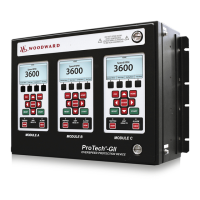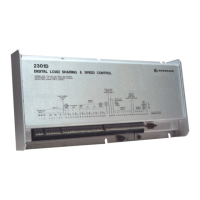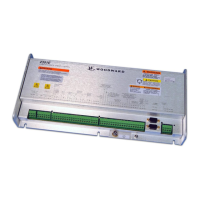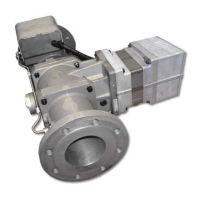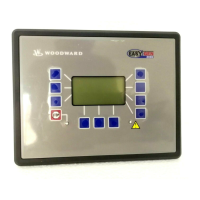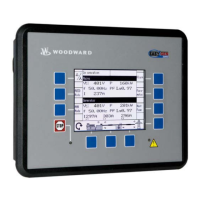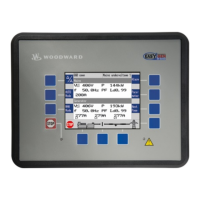Manual 37278B GCP-30 Series - Genset Control
Page 50/174 © Woodward
Load And/Or Var Sharing
The control ensures load and/or var sharing adjusted to the rated power of the generators under every operating
condition (mains parallel operation, isolated operation in parallel with other gensets, or reverse synchronization
of the busbar to the mains).
The controls with the GCB close and not in constant/base load mode will load and/or var share.
The rated power of the generators is max. 10 MW. Thus, up to 14 generators with a maximum of 10 MW each
may share the power.
Operating in mains parallel with mains interchange (import/export) real power control: Each controller
participating in load/var sharing controls the generator set to which it is assigned so that the real power set point
at the mains interchange remains constant. The real power set point for the mains interchange must be configured
identically in each controller.
All controllers communicate via a CAN bus. This enables the controllers to adjust the real power generated by
the generator while remaining within the rated power of the generator. A smaller generator will contribute less
real power as compared to a large generator, but they will both be utilized to the same capacity factor. An exam-
ple of this would be a 100KW generator and a 1000KW generator and a mains interchange of 825KW. The
100KW generator would contribute 75KW and the 1000KW generator would contribute 750 KW or both genera-
tors would be at 75% of their rated capacity.
No reactive power sharing is performed when operating in parallel with the mains. The reactive power will be
defined by the configured power factor set point of the individual controllers.
The parameter "kW/kvar sharing: reference variable kW" can be used now to define the priority of the reference
variable (real power at interchange) for real power sharing. A higher percentage influences the control more to-
wards the real power set point for the interchange. A lower percentage influences the control more towards real
power sharing.
The parameter "kW/kvar sharing: reference variable kvar" has no influence here.
Isolated operation in parallel: Each controller participating in load/var sharing controls the generator set to
which it is assigned in such a manner that the set frequency and the set voltage at the bus remain constant. This
makes it imperative that the same frequency and voltage set points are configured for each controller.
All controllers communicate via a CAN bus. This enables the controllers to adjust the real power generated by
the generator while remaining within the rated power of the generator. A smaller generator will contribute less
real power as compared to a large generator, but they will both be utilized to the same capacity factor. An exam-
ple of this would be a 100KW generator and a 1000KW generator and a load of 825KW. The 100KW generator
would contribute 75KW and the 1000KW generator would contribute 750 KW or both generators would be at
75% of their rated capacity.
The reactive power will be allocated in a way that it is the same for all generators involved.
The parameter "kW/kvar sharing: reference variable kW" can be used now to define the priority of the reference
variable (frequency) for real power sharing. A higher percentage influences the control more towards frequency
control. A lower percentage influences the control more towards real power sharing.
The parameter "kW/kvar sharing: reference variable kvar" can be used now to define the priority of the reference
variable (voltage) for reactive power sharing. A higher percentage influences the control more towards voltage
control. A lower percentage influences the control more towards reactive power sharing.
Reverse synchronization of the busbar to the mains: Distribution is carried out according to the type of iso-
lated operation. The set point value for the bus frequency is determined by the mains frequency + df
max
/2.
Example: If df
max
= 0.2 Hz, this results for df
max
/2 = 0.1 Hz (i.e. in a system of 50 Hz, the busbar will be raised to
50.1 Hz).
The relay issues "Command: close GCB" to all controls so they may be paralleled.

